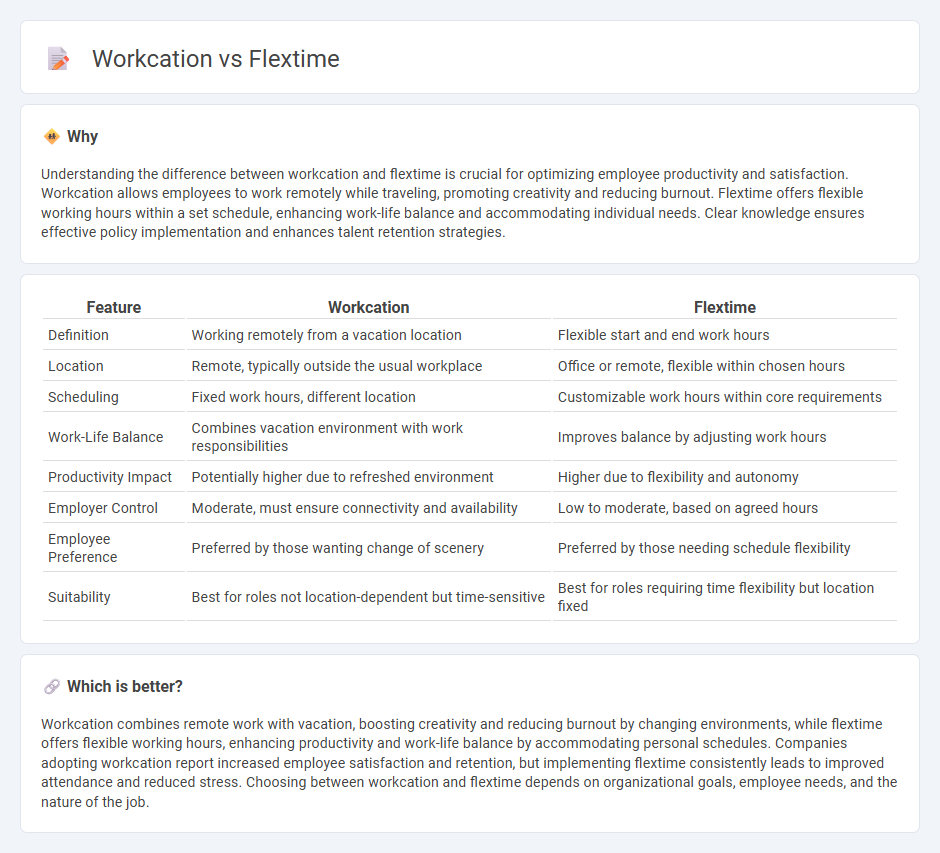
Workcation and flextime represent innovative approaches to employee work arrangements that enhance flexibility and work-life balance. Workcation combines remote work with travel, allowing employees to maintain productivity while exploring new environments, whereas flextime provides customizable work hours tailored to individual preferences and peak performance times. Discover how integrating these models can transform workplace dynamics and boost employee satisfaction.
Why it is important
Understanding the difference between workcation and flextime is crucial for optimizing employee productivity and satisfaction. Workcation allows employees to work remotely while traveling, promoting creativity and reducing burnout. Flextime offers flexible working hours within a set schedule, enhancing work-life balance and accommodating individual needs. Clear knowledge ensures effective policy implementation and enhances talent retention strategies.
Comparison Table
| Feature | Workcation | Flextime |
|---|---|---|
| Definition | Working remotely from a vacation location | Flexible start and end work hours |
| Location | Remote, typically outside the usual workplace | Office or remote, flexible within chosen hours |
| Scheduling | Fixed work hours, different location | Customizable work hours within core requirements |
| Work-Life Balance | Combines vacation environment with work responsibilities | Improves balance by adjusting work hours |
| Productivity Impact | Potentially higher due to refreshed environment | Higher due to flexibility and autonomy |
| Employer Control | Moderate, must ensure connectivity and availability | Low to moderate, based on agreed hours |
| Employee Preference | Preferred by those wanting change of scenery | Preferred by those needing schedule flexibility |
| Suitability | Best for roles not location-dependent but time-sensitive | Best for roles requiring time flexibility but location fixed |
Which is better?
Workcation combines remote work with vacation, boosting creativity and reducing burnout by changing environments, while flextime offers flexible working hours, enhancing productivity and work-life balance by accommodating personal schedules. Companies adopting workcation report increased employee satisfaction and retention, but implementing flextime consistently leads to improved attendance and reduced stress. Choosing between workcation and flextime depends on organizational goals, employee needs, and the nature of the job.
Connection
Workcation and flextime both enhance employee flexibility by allowing individuals to choose when and where they complete their tasks, thereby improving work-life balance and productivity. Flextime permits employees to set personalized working hours, while workcation integrates remote work with travel, combining leisure and professional responsibilities seamlessly. Organizations adopting these practices report higher job satisfaction, reduced burnout, and increased talent retention in the competitive human resources landscape.
Key Terms
Flexible scheduling
Flexible scheduling enhances employee autonomy by allowing work hours to be adjusted around personal commitments, increasing productivity and job satisfaction. Flextime primarily offers varied start and end times within workdays, while workcation combines remote work with travel, emphasizing location flexibility. Explore how flexible scheduling can transform your work-life balance and operational efficiency.
Remote work
Flexitime allows remote workers to customize their work hours around peak productivity times or personal commitments, enhancing work-life balance and reducing burnout. Workcations combine remote work with travel, enabling employees to work from different locations while maintaining professional responsibilities, fostering creativity and job satisfaction. Explore how integrating flexitime and workcation strategies can transform your remote work experience.
Work-life balance
Flextime allows employees to customize their work schedules, promoting a better work-life balance by accommodating personal commitments and reducing stress. Workcations combine remote work with vacation settings, enabling professionals to refresh their minds while maintaining productivity. Explore how these flexible approaches can enhance your work-life harmony and boost overall well-being.
Source and External Links
Flextime - Wikipedia - Flextime is a flexible work schedule that allows employees to adjust their start and finish times, typically with a core period when all must be present, while still completing required daily, weekly, or monthly hours.
Flex Time: Definition and Examples | Indeed.com - Flex time lets employees choose their arrival and departure times--for example, starting at 8:30 a.m. one day and 10 a.m. the next--as long as they complete their required hours, promoting work-life balance and potentially increasing productivity.
What is Flextime? Definition and Understanding its Benefits - Flextime is a work policy that allows staff to customize their workday schedule outside of a set core period, helping employees balance professional and personal needs more effectively.
 dowidth.com
dowidth.com